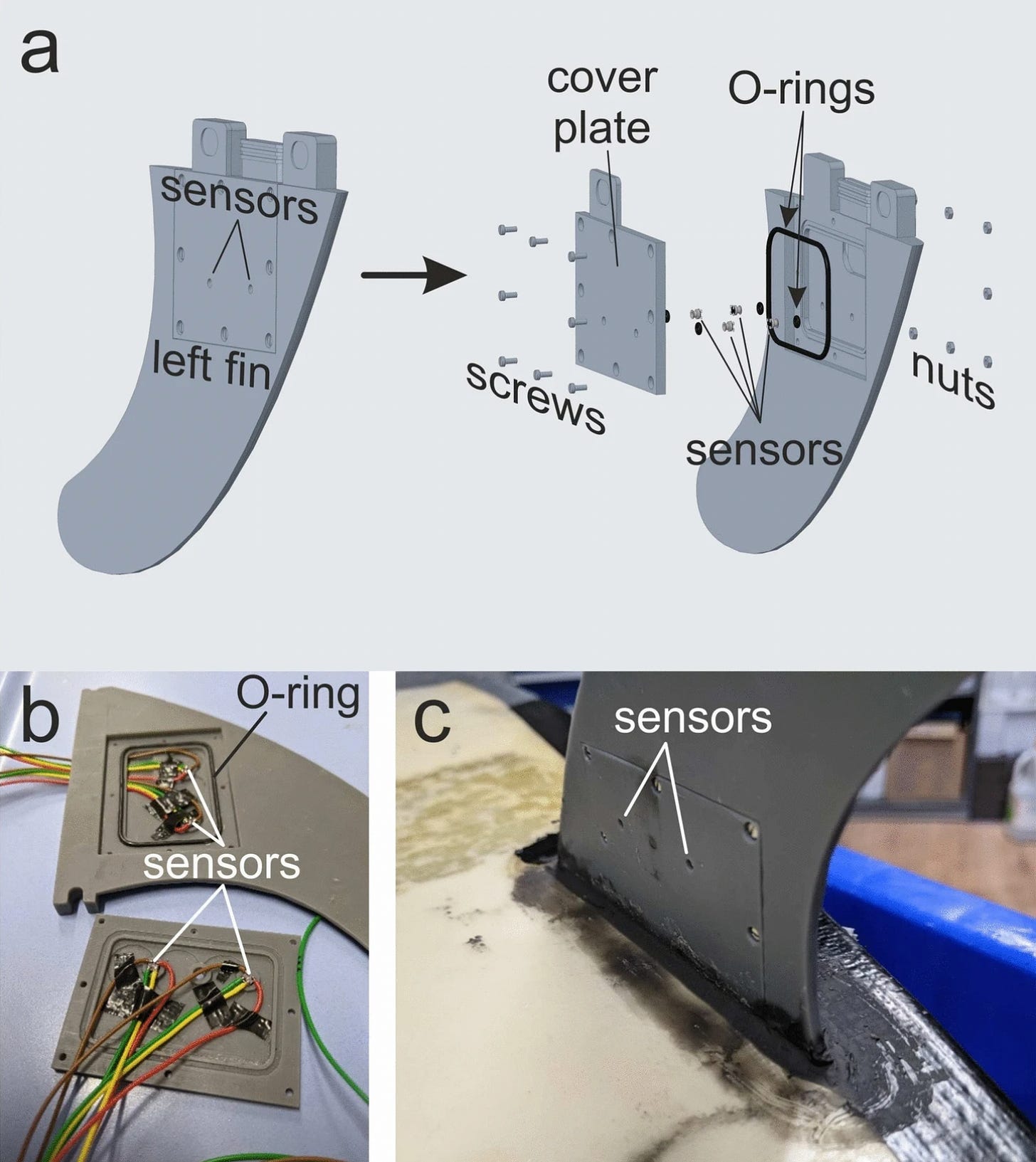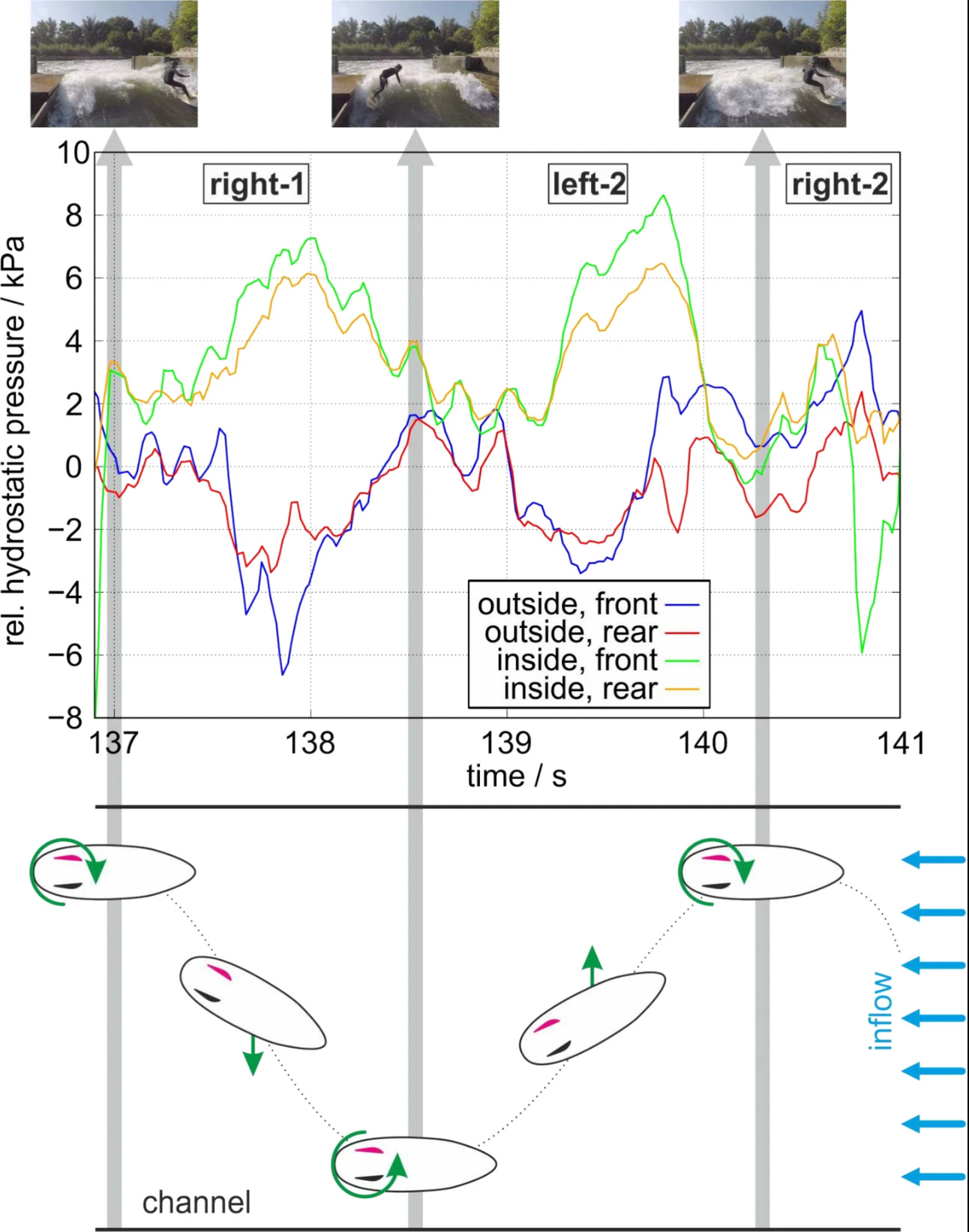Computational fluid dynamics models have been predicting surf fin behavior for years, but nobody had actually measured what fins experience during real surfing until a team of German researchers stuffed pressure sensors into a 3D-printed fin and took it to a river wave.
The engineering challenge was considerable. Performance fins max out around 7mm thick, leaving minimal space for sensors, wiring, and waterproofing. The team embedded four pressure sensors into a custom fin modeled after the FCS G5 Tri design - two on each side positioned at different points along the fin’s length. The sensors connected via wires threaded through channels in the board to a waterproof box containing an Arduino controller, batteries, and a microSD card. After validating the system’s accuracy in a water tank where they submerged it to various depths and compared measured pressures against known values, they mounted the instrumented fin in a twin-fin setup and headed to the Fuchslochwelle river wave in Nürnberg.

River waves offer something ocean waves can’t: consistency. The Fuchslochwelle holds its shape hour after hour, allowing the surfer to repeat the same maneuver multiple times under nearly identical conditions. The wave itself runs about a meter tall with flow velocities around 4 m/s, fast enough to surf but controlled enough for meaningful data collection. A certified river-ripper took the board through three complete cycles, carving from one side of the channel to the other and back, executing the kind of drawn-out turns that river surfing demands. Between runs, the team checked the waterproof box, confirmed the sensors were recording, and watched the pressure traces accumulate on the memory card.
During each crossing, the instrumented left fin developed increasing pressure differences as the surfer accelerated, peaking around 20 kPa at mid-traverse when velocity maxed out. The pressure then decreased as the surfer decelerated approaching the channel edge. That peak difference translates to approximately 300 N, or about 70 pounds of force pushing the fin away from the board’s centerline.
What surprised the researchers was the consistency in their measurements throughout the run. The pressure difference maintained the same direction whether the surfer traveled left or right across the channel. The fin’s curved outside surface always experienced lower pressure than its flat inside surface, creating that outward push regardless of travel direction. This confirmed something that we have long assumed but never proven with actual measurements.

The toe-in angle explains this consistency. When traveling right, water flows past the fin from the right side. When traveling left, water flows from the left. Without toe-in, these opposite flow directions would hit the fin’s curved surface from completely different angles, sometimes working, sometimes not. The 4-degree toe-in pre-angles the fin so that both flow directions encounter the curved surface at similar angles. The fin essentially splits the difference between the two travel directions, maintaining its lift-generating orientation throughout the turn.
In a twin-fin setup, both fins push outward, creating opposing forces that resist the board sliding sideways down the wave face. That 70-pound outward push on each fin provides the resistance your back foot pushes against during turns. Without it, the board would skitter across the water rather than hold a line. But those opposing forces also resist quick transitions - changing from one turn to another means overcoming that 70-pound resistance on each side. The measurement quantifies the fundamental tradeoff in fin design: more outward force means more stability but harder work to initiate direction changes.
Larger fins generate more force, providing stability but requiring more effort to redirect. Smaller fins reduce that force, making the board feel looser and more responsive but less planted. The 300 N measured here represents a specific point on that continuum - a twin-fin setup with medium-sized fins on a moderate river wave. Scale up to bigger waves with higher velocities, and those forces increase exponentially, which explains why the same board can feel just loose enough in small surf but sluggish in overhead conditions.
The instrumented fin represents the first direct measurement of hydrodynamic pressure during actual surfing. Previous work measured fin flexing as an indirect indicator, but pressure data directly validates the computational models that have dominated surf hydrodynamics research. Fin designers can now truly optimize toe-in angles using actual pressure measurements showing how different values affect force generation across various maneuvers, rather than relying on tradition or subjective feel. The next generation of fins might look similar to current designs, but their angles will be chosen from data rather than educated guesses.
Further Reading:


Did you see this?
https://www.quantamagazine.org/the-hidden-math-of-ocean-waves-crashes-into-view-20251015/
Those educated “guesses” have come from a deep
practical knowledge of surfboard design and precise performance feedback from the best surfers in the world over several generations. The science and data so far, based on your piece, have only got as far as what every shaper already knows. I suspect the
leap to being able to lead innovation is greater than you think.